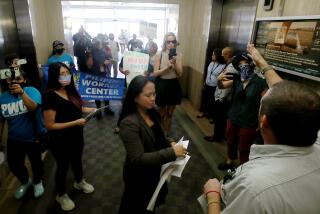Southern California Job Market : The WORKPLACE : WHAT YOU GET : Here’s a Guide to the state’s workers compensation system
- Share via
Each year, thousands of Californians injured on the job learn that, except under the rarest of circumstances, they cannot sue their employers, even if they believe that their injuries are their employers’ fault.
Injured employees are entitled only to benefits under a no-fault system called workers compensation. This system began 75 years ago when employees traded their right to sue--and perhaps lose--for modest, but sure benefits. These include free medical care, now up to $224 a week in lost wages, and small sums to compensate for permanent physical losses: $840, for instance, for the loss of a finger; $13,000 for the loss of an eye. Since 1975, injured workers unable to return to their old jobs have also been entitled to free retraining.
Here are some answers to some commonly asked questions about the system.
Question: Who is entitled to workers’ compensation?
Answer: Virtually every worker whose injury “arises out of and in the course of employment,” regardless of whose fault the injury was. A worker is entitled to benefits even if he had his affliction to begin with and work just made it worse.
Q: What should a worker do if he’s injured on the job?
A: Report his injury to his employer, who is required to notify state government and the employer’s workers compensation insurance carrier.
Q: Can an injured worker go to his own doctor for the free treatment?
A: Only if he told his employer before his injury that he wants to visit his own doctor, clinic or health maintenance organization. Otherwise, to obtain free medical care, the injured worker must visit the doctor of his employer’s choice for the first month of treatment. After that, the worker can pick his own doctor for treatment, but must submit to examinations by the employer’s physicians if they wish to evaluate his case.
Q: What should an injured worker do if he suspects his injury is work-related, but is not sure--if, for example, he is having symptoms such as aches and pains?
A: See a doctor. If he thinks your injury is work-related, he is legally obligated to inform state government. Then tell your boss.
Q: What if your boss and his insurance company dispute your doctor’s assessment?
This is often the case with so-called cumulative injuries--less obvious injuries that creep up over a long period. You spend years digging ditches, for example, and your back finally wears out. If the company disputes the work-related nature of your back injury, then, to obtain workers comp benefits, you have to file a claim with the Workers Compensation Appeals Board. Ultimately, it will be up to a judge to decide if your injury is work-related. Meanwhile, if your back hurts too much to work, you can obtain state temporary disability benefits--a maximum of $224 a week, the same as workers compensation benefits.
Q: Are there places you can go for advice on how to pursue a disputed claim?
A: Kenneth Draft, acting chief of the information and assistance bureau of the state division of industrial accidents, suggests calling one of his 20 information and assistance officers spread around California. “We’ll tell you what we think of your case,” Draft said. Union officials are usually acquainted with the system. Plus there are lawyers who specialize in workers compensation cases. You can find them in the Yellow Pages.
Q: When do I need a lawyer?
A: You can file a case before the workers compensation appeals board yourself. But, said Melvin S. Witt, editor and publisher of California Workers’ Compensation Reporter, which keeps track of developments in workers compensation law, “the only sound counsel as far as I’m concerned is that if you have any kind of injury that’s serious, you should have an attorney.” Witt, a former insurance company lawyer and chairman of the appeals board, said that even well-meaning insurance company claims adjusters are so overworked that “cases just sit their on their desks” and injured workers “get the runaround.” Having a lawyer sometimes helps.
Q: How much does a lawyer cost?
A: Lawyers take these cases on a contingency basis and judges award them from 9% to 15% of an injured worker’s permanent disability award.
Q: How do these cases end?
A: At some point, an injured worker’s condition stabilizes. It becomes, in workers compensation parlance, “permanent and stationary.” The doctor says go back to work or, if the employee remains unfit to resume his former job, begin retraining, said Michael Gerson, who represents injured workers and is president-elect of the California Applicants Attorneys Assn. The extent of the worker’s permanent disability is assessed as a percentage of disability--reflecting his diminished ability to compete in the open labor market. He either settles his case with the insurance company or pursues a permanent disability award from a workers compensation judge. These awards are usually payable in increments of $140 a week.
Q: How would a workers compensation plan under consideration by the Legislature change things?
A: All but the lowest-paid workers would get more benefits. The lowest paid workers would get less. Temporary disability payments would rise to a maximum of $511 by 1992. Mental stress claims that don’t involve physical injury would be severely limited. Employees would have to pay half of their permanent disability awards for job retraining. Insurance companies would be penalized if they didn’t pay workers promptly.
Q: What are the rare circumstances in which an injured worker can sue his employer for damages?
A: If his employer physically attacks him, hides knowledge of a hazard--such as a dangerous chemical--that he knows is giving his workers a disease, deliberately removes an equipment safety guard, or manufactures the piece of equipment on which his employee gets hurt.
More to Read
Inside the business of entertainment
The Wide Shot brings you news, analysis and insights on everything from streaming wars to production — and what it all means for the future.
You may occasionally receive promotional content from the Los Angeles Times.










